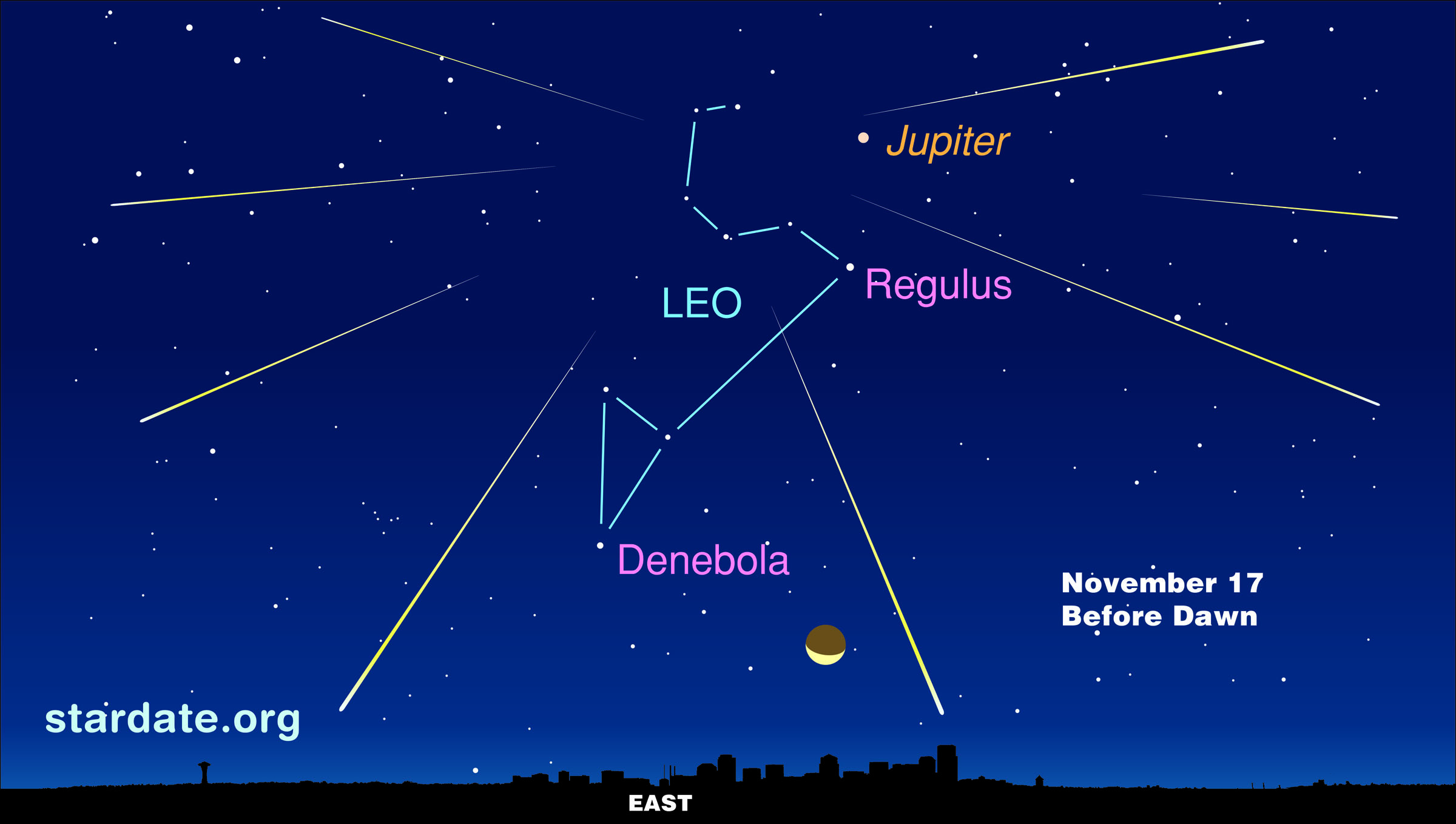Leonid Meteor Shower Peaks Monday: How to See It

Stargazers hoping to catch a glimpse of some meteors should look to the predawn sky early next week.
The Leonid meteor shower is forecasted to peak Monday afternoon (Nov. 17) in the U.S. eastern time zone, so stargazers in the United States are advised to look to the skies between midnight and dawn on Monday and Tuesday morning for the best view, astronomers say.
This year, the Leonid meteor shower should treat skywatchers to beween 10 and 15 meteors per hour, NASA meteor expert Bill Cook, head of the Meteoroid Environment Office at the agency's Marshall Space Flight Center in Huntsville, Alabama, told Space.com. For some meteor showers, that's considered a decent rate. [Photos: Most Amazing Leonid Meteor Shower Photos]
![Learn why famous meteor showers like the Perseids and Leonids occur every year [See the Full Infographic Here].](https://cdn.mos.cms.futurecdn.net/VDWEKQFLr8yuXkTL4YkHqj.jpg)
But the Leonids have a lot to live up to: In peak years, this meteor shower — which occurs every November — has produced meteors at a rate of 1,000 or more per hour. A year like that is unlikely to happen again for the Leonids until around 2034.
To have the best chance of spotting meteors, you should go to a location away from city lights, dress warmly, lie flat on your back and look straight up, Cooke said in a statement. No special viewing equipment is needed to see the Leonid shower; it can be seen with the naked eye.
The "shooting stars" from the Leonid meteor shower appear to come out of the constellation Leo, which will climb into view in the northern hemisphere after midnight. The meteors are bits of dust and rock from the tail of Comet Tempel-Tuttle, which does a loop around the sun every 33 years. Every November, Earth passes through the debris field left behind by Tempel-Tuttle, and the bits of debris "ram into the atmosphere at tens of thousands of miles an hour," according to StarDate magazine. The dust and rocks burn up in the atmosphere, creating the gorgeous light show seen on Earth.
Indoor viewing options
If skywatchers don't feel like going out in the cold, both NASA's Meteorite Environment Office and the Slooh Community Observatory will broadcast the shower live.
Get the Space.com Newsletter
Breaking space news, the latest updates on rocket launches, skywatching events and more!
NASA's live stream will include a sky view from a telescope at Marshall Space Flight Center in Alabama. That stream will begin on Monday, Nov. 17 at 7:30 p.m. EST (0030 GMT Tuesday) and will continue until sunrise on Tuesday Nov. 18.
You can watch the Leonid meteor shower webcasts on Space.com, courtesy of Slooh and NASA.
Cooke noted that some astronomers have predicted that a second peak of this year's Leonid meteor shower will occur Thursday, Nov. 20. If those predictions are correct, skywatchers will see meteors created by debris left behind by Comet Tempel-Tuttle in 1567.
As the comet rounds the Earth, its debris field is stretched out by the gravity of Jupiter, Cooke said. Occasionally, the pull of gravity stretches portions of the debris into filaments, and this year, there's a chance Earth will pass through a filament of debris that is almost 450 years old.
Editor's note: If you snap an amazing photo of the Leonid meteor shower of November 2014, or any other night sky view, and you would like to share it for a possible story or image gallery, send your images and a description of the view and equipment in to managing editor Tariq Malik at spacephotos@space.com.
Follow Calla Cofield @callacofield.Follow us @Spacedotcom, Facebook and Google+. Original article on Space.com.
Join our Space Forums to keep talking space on the latest missions, night sky and more! And if you have a news tip, correction or comment, let us know at: community@space.com.

Calla Cofield joined Space.com's crew in October 2014. She enjoys writing about black holes, exploding stars, ripples in space-time, science in comic books, and all the mysteries of the cosmos. Prior to joining Space.com Calla worked as a freelance writer, with her work appearing in APS News, Symmetry magazine, Scientific American, Nature News, Physics World, and others. From 2010 to 2014 she was a producer for The Physics Central Podcast. Previously, Calla worked at the American Museum of Natural History in New York City (hands down the best office building ever) and SLAC National Accelerator Laboratory in California. Calla studied physics at the University of Massachusetts, Amherst and is originally from Sandy, Utah. In 2018, Calla left Space.com to join NASA's Jet Propulsion Laboratory media team where she oversees astronomy, physics, exoplanets and the Cold Atom Lab mission. She has been underground at three of the largest particle accelerators in the world and would really like to know what the heck dark matter is. Contact Calla via: E-Mail – Twitter









